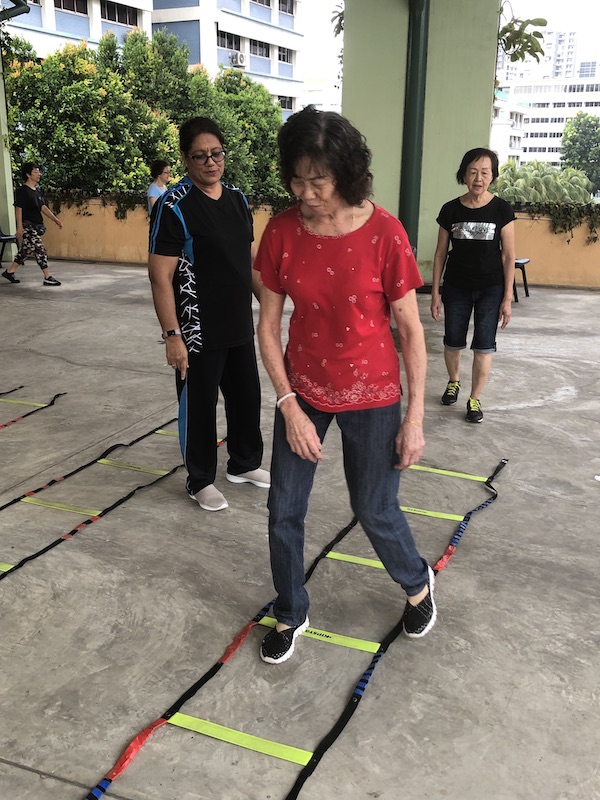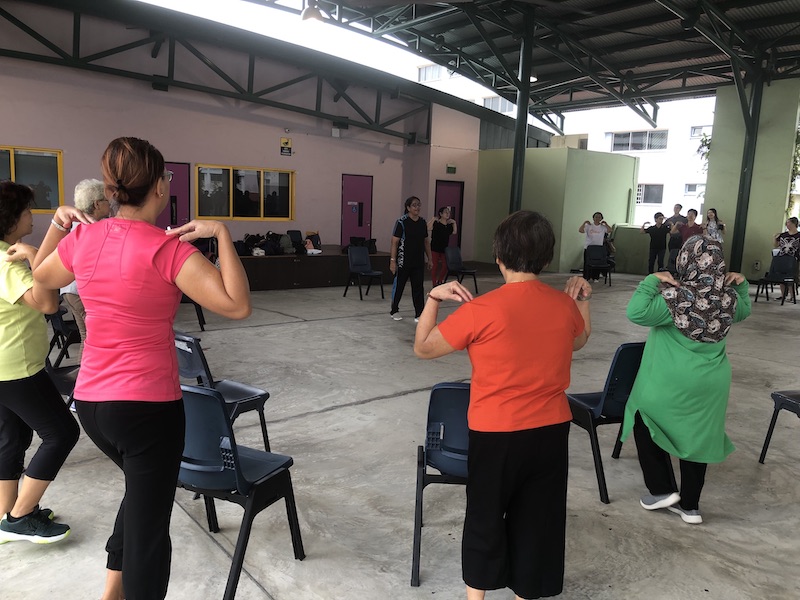A HAPPYer you
NUHS community-based initiative that combines physical and mental exercises is set to expand islandwide.
BY: Eleanor Yap
Ahsathiamal Subramanian, 64, couldn’t be happier being a part of a community-based initiative combining physical and mental exercises called HAPPY (Healthy Ageing Promotion Programme For You). After more than a one year in the programme, she not only has managed to drop her sugar level from pre-diabetic to optimal, but she has also found that she is now fitter and with an improved mental alertness.
The programme run by the National University Health System (NUHS), currently is at 40 sites mostly in the West region including at Bukit Panjang Community Club where Ahsathiamal is at. NUHS has big plans – to partner with the Agency for Integrated Care (AIC) to gradually spread HAPPY to a total of 130 sites islandwide.
Since its inception in August 2017, more than 700 seniors have so far participated in HAPPY, which is designed to stimulate cognitive functions, improve physical ability and delay or prevent dementia. HAPPY is adapted from Cognicise (a combination of cognition and exercise), an exercise programme designed by the National Centre for Geriatrics and Gerontology (NCGG) in Japan.
While doing physical exercises, participants have to simultaneously carry out cognitive activities of varying complexity (known as dual-task exercises). For instance, participants may be asked to march on the spot while counting backwards from 30 and clapping on every third number, or participants play “Scissors, Paper, Stone” while marching, but requiring that they play to lose (not win). Research have shown that a combination of exercise and cognitive task elicit widespread brain network activation across fronto-temporo-parietal areas.
According to NUHS, exercises in HAPPY have been modified from the Japan exercises and each week they are different. Sessions run for one hour and may run twice a week. There is also a circuit training which includes a step board for participants to climb up and down, ladder to help seniors think on the move, and resistant band to improve upper body strength and correct poor posture.
As part of the evaluation of the programme, 512 seniors over 60 and above were screened and 269 of them were enrolled because they were either pre-frail or frail, or have underlying memory issues. Of the 269 enrolled seniors, 115 have completed the six-month screening and follow-up and the results have been positive. Amongst the pre-frail and frail, 50 percent improved in their depression scores and 40 percent of the cohort (pre-frail, frail and those with underlying memory issues) improved in their depression scores. Also, the number of seniors falling at least once was reduced by 40 percent, and almost over 50 percent improved in their frailty level.
Other results also showed evidence that the programme is beneficial. Seventy percent improved in their walking speed, balance or standing up from the chair, and 74 percent improved in their memory scores. Subjective memory complaints from seniors who felt their memory was not so good dropped from 63.2 percent to 46.9 percent, while the prevalence of those who felt moderately or extremely anxious or depressed dropped from 7.2 percent to 2.7 percent. According to NUHS, the 115 seniors will be further evaluated for a period of one year.
Shared Associate Professor Reshma Merchant who leads the programme, and is the head and senior consultant, Division of Geriatric Medicine, National University Hospital (NUS): “The good news is that Singaporeans are living longer. But we also want to enable Singaporeans to live better. Frailty and memory decline, in particular are two aspects of ageing that are reversible.”
Another aspect of HAPPY is that the programme encourages seniors to volunteer and contribute back as trainers leading the exercise, and sharing health and nutritional tips with participants. To date, more than 270 volunteers have attended the training sessions, with over 130 fully-certified by the programme therapist. Ahsathiamal is one of the volunteers. She shared: “After retiring, I wanted to give back to society so I decided to volunteer.” Six months after participating in HAPPY, she went on to do the training which includes three theory classes and three on-site trainings and assessment. Today, she plans out the one-hour sessions twice a week and conducts them.
She also revealed a bonus of HAPPY. The mother of two shared that she has made new friends from the programme and has “experienced new ways of life” such as going out to eat together. Ahsathiamal said that when her husband passed away in December last year, many in the HAPPY programme at Bukit Panjang Community Club came down to support her.
“All of them coming to the house and they came for the funeral. I didn’t know them well and they still came to the funeral – people from all walks of life and different races. They stayed and comforted me. That for me was heartwarming and I was blown away by this. When I came back to the lead the programme, they would check in on me. I would not have met them without this programme.” She also shared that even during celebrations, the group of around 12 would all get together. “When someone goes overseas, everyone would get a souvenir and if someone’s birthday, everyone gets a makan session paid for by the birthday person.”
Another senior, Sadiah Kasbie, 64, who is part of the HAPPY programme at Choa Chu Kang Community Club, has been with the programme for one year and like Ahsathiamal, she couldn’t be happier. “I wanted to do more exercise and to keep my mind active. I have gained more friends and feel happy. It has changed my life as I was always at home while my husband and children were working.”
** The HAPPY programme is free. For those who want more information or to sign up as a volunteer, e-mail to: healthy_ageing@nuhs.edu.sg.




I wish to participate
Hi, Guat Teck, I have e-mailed you directly on this.
Hello. I am from Romania, a specialist in the rehabilitation of the elderly. I read about HAPPY program and was impressed with the results. Unfortunately, I cannot find the methodology anywhere, but I would like to use the methods in my work. I would be grateful for any information that you can share with me about this.
Hi, Yana, you might want to write to them at the e-mail provided in the article to get that information.